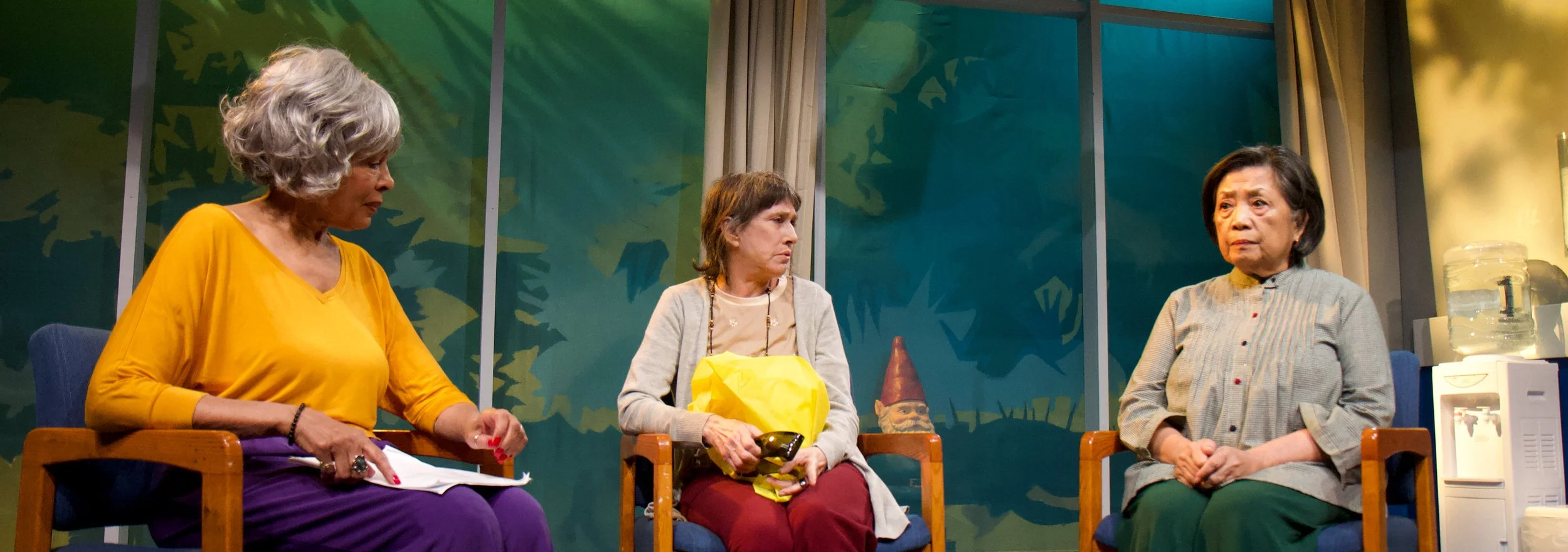The illusory brand of theatrical magic is difficult to find—especially in solo shows. Precious few one-man productions can effectively create that beautiful “baseless fabric” of a transportive play, and even then, their illusions are sometimes imperfect. A single body moves across a deserted stage with not much else but light and music and those elemental players for company. It’s easy to falter when carrying the weight of performance alone, but writer/comedian Terri Girvin, the multi-character star of director Michael Leeds' production of Last Call at the IRT Theater, bolsters an otherwise ordinary tale of a long-serving New York bartender with surprising humor and extraordinary moments of intimacy.
Pools of soft, yellowing light accompany Terri Girvin as she moves through her life story. She begins with a series of easy jokes; "Top 10 Ways to Annoy Your Bartender" is a recurring and sometimes quite delightful theme that runs through her monologues. She then proceeds to insert details of her family’s dysfunctional history in momentary, painful snapshots. These scenes are relayed with grim amusement on Girvin’s part, as it is her mother, a divorced, drink-happy ex-party clown who is the source of this dysfunction. Here, Girvin’s practiced, punch-line-delivering style gives way to the emotional drama of her relationship with her mother. Halfway through the play, the audience becomes unsure of its laughs, and seem more comfortable in silence.
But the scenes themselves are transitory. They seem more like floating motes of experiential anecdotes rather than seamless parts of an organic autobiography. Here is where Girvin’s talent for stand-up comedy interferes slightly with theatrical storytelling. The moments in which Girvin’s mother steps onto the stage in the guise of her own daughter are short; Girvin impersonates her mother uneasily, and is keen to relieve her audience’s tension with a joke. It’s easy for the audience to see that Girvin’s mother is an emotionally dependent, paranoid, unstable and completely unfit parent, but somehow her daughter doesn’t realize that this legacy is in her hands until the end. Consequently, Girvin’s mother, only heard and not seen, is never fully redeemed. For most of the production, she is a two-dimensional weight on her daughter’s shoulders. Girvin, by her own reckoning, deeply desires “freedom from the weight of her [mother’s] trauma.”
Regardless of these dips in storytelling, it is apparent that Girvin is the only person from her family who can stand her mother’s antics. She also seems, by her own telling, to be more involved in her mother’s disorganized life than her largely indifferent brothers. Girvin’s brother is especially blunt: “It’s fun when the circus comes to town, but when the circus never leaves!” A particularly hectic night at the bar sees Girvin taking close to 50 orders every 10 minutes. It is perhaps the aural and visual climax of the entire production. Girvin’s silent co-stars put on terrific performances, as evidenced by the unique collaboration between Grammy-nominated sound designer Phil Palazzolo and lighting designer Jason Fok.
With not a single prop in sight, Girvin clinks imaginary shot glasses onto the bar and pours fizzing drafts of beer into empty steins. She chats genially with the disembodied voices of her customers and slams a nonexistent cash register closed before turning to the audience and grinningly inquiring, “What can I getcha?” Every delectable sound, from the dull roar of conversation to the sloshing of a drink, matches in near-perfect synchronicity with Girvin’s expert movements. Every voice has its own extraordinarily ordinary life; Palazzolo and Fok have squeezed alchemical gold from the listless air with their superb intertwining of light and sound.
But the harmony of Girvin’s movements, in perfect beat and cadence to the swing of her bar, quickly devolves into chaos when she receives a call from her mother. Without revealing Girvin’s mother’s shocking escapade, and the proverbial last straw for Girvin herself, the harried and exhausted bartender ends up kicking everyone out of her bar. She listens shamefacedly to her customer’s insults and drunken raging (who only minutes before had flirted, smiled or laughed with her). She then slams her phone onto the bar, looking out teary-eyed and tired at her arrested audience as we wonder: Was that their last call?
It is this explosive scene that discloses the fundamental problem Girvin has with marrying the architecture of her life to that of her mother. We are never sure if she takes up the Sisyphean task of maintaining any semblance of a relationship with her mother after this. But this unmarried, diminutive, middle-aged working woman is still a hopeful, optimistic child at heart. Her ever-cheerful retort to the dull greeting, “How are you?” is a loud, “Living the dream!” The final scene is nostalgically beautiful, and we stitch up her disparate stories of love, loss and emotional pain into a safe blanket we wish we could cover her in. And in perhaps the most moving, and most fitting, end to this darkly humorous tale of a life not yet fully lived, Girvin leaves us with no ending. We only have her memories.
Last Call ran from Oct. 9-Nov. 1 at the IRT Theater (154 Christopher St., #3B) in Manhattan. For more information, visit www.terranovacollective.org.








